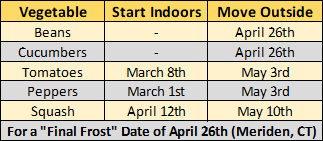Looking for some help deciding when to plant this spring? No matter if you’re a seasoned gardener or just looking to try it out, you need some information on the types of plants you're adding to the garden. You need to know the best time to plant, and it just so happens that the weather will impact that decision. There is a lot that goes into this equation, but for the sake of simplicity, we will focus on two main things: your location, and what you’re trying to put in the ground.
First, let’s talk about location. Where you live is a huge part of deciding when to plant certain types of vegetables, fruits, etc. Knowing the first and last dates a frost and/or freeze can occur will help you out immensely!
We’ve already written about average dates for a few different locations in the Northeast before, but we know not everyone lives in the Mid-Atlantic, Northeast, or Midwest. That’s just where most of our footprint lies. Fear not, though, if you live somewhere else. All the info you need is right here.
Fortunately, our friends at the U.S. Department of Agriculture have developed
Hardiness Zones that will help you make these decisions. Your location will determine which zone you are in. This information is based upon climatology, and is intended as a guide - experience and knowledge of your area will help out even more.
You can tell that these maps are based upon climatology by looking for typically cooler areas. For example, in New Jersey, there are a variety of locations that end up cooler than surrounding regions for a whole host of reasons. The Pine Barrens are one of them, and the rolling hills of Sussex and Warren Counties are another. These show up well on these maps.

So, when is the best time for you to plant in your zone? First, you need to find your zone. For example, our hometown of Hackettstown, NJ is in Zone 6a. Most of the Northeast, Midwest, and Mid-Atlantic reside within Zones 6 and 7, though those further north end up in Zone 5. You can easily find your zone using the zip code finder tool on the
USDA site. Once you know your zone, you can use that to learn the best time to start seeds and plant them.
There is a ton of information out there on when is the "best" time to begin planting a select variety of vegetable, fruit, etc. We found sites
like this one that have
easy to read graphs on when some good times to start various types of plants, but like we mentioned earlier, these hardiness zones and background info serve only as a guide.
For plants/seeds that need more time to grow, you can “start them” inside, in a climate-controlled environment, before transferring and planting them outside. Knowing average last frost/freeze dates can be helpful, and above you will find just a sampling of information for a few cities around our area. Places that see frost/freeze potential late into spring (like in New England and plenty of areas in the Midwest) can make it tough to decide when to move seeds and plants outside so try finding more detailed information on your area in the Hardiness Zones finder we mentioned above.
But, for some examples, we will pull in some information based on the average last frost/freeze date in Meriden, CT. If you live (or were to live) in this area, then below will be some example dates of when you would try to start seeds indoors or try to plant outdoors... but remember, these are just guides! Local weather conditions and things like how shaded/sunny your garden is will have a big impact.




